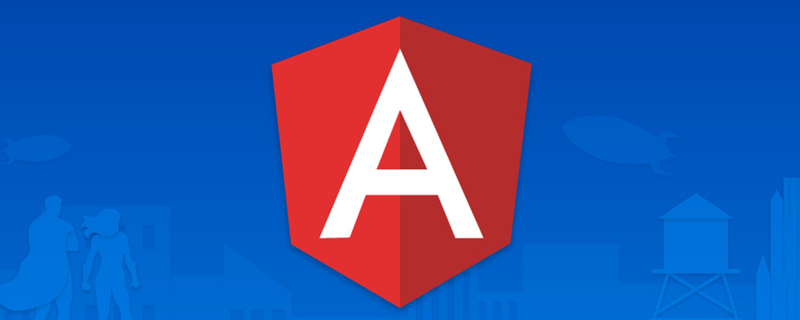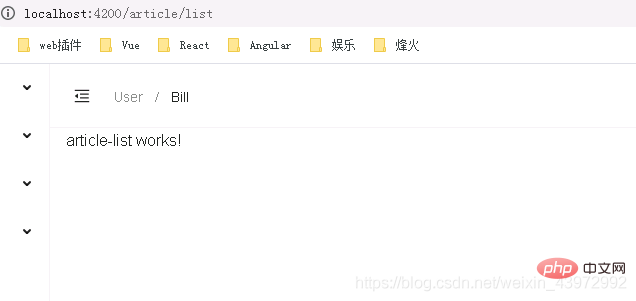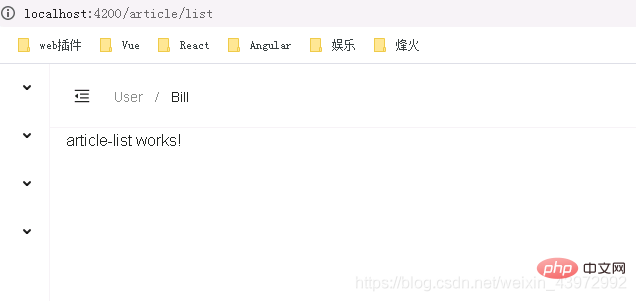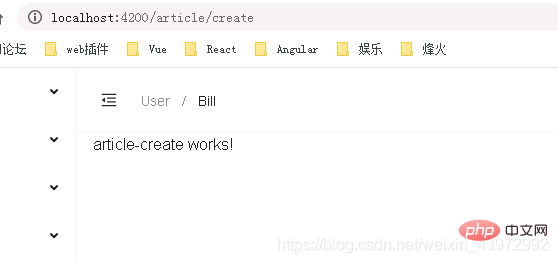Detailed explanation of Angular root module and feature module
This article will take you through the feature templates and root templates in Angular. It has certain reference value. Friends in need can refer to it. I hope it will be helpful to everyone.

The premise is that Angular cli is installed. Most of the following file creation depends on cliProvided directives
<span style="font-size: 20px;">Angular</span>The attribute template and root template (<span style="font-size: 20px;">AppModule</span> )
The difference is that feature templates can divide applications. My personal understanding is similar to componentization
1. Feature templates The created command ng g module article, here is ng g module article --routing, which can generate a article-routing.module.ts routing file
2. At this time, CLI will create another folder article, article file under the app folder The folder contains two files article.module.ts and article-routing.module.ts
3. Use ng g component to generate For two components, the specified template is article. The specified template will be automatically imported into article.modules.ts and registered in the declarations array, Note: Do not delete the components registered in declarations, otherwise some specifications in the components will become unusable
- ng g component description
-
ng g component article/article-list -m=article, generatearticle-listfolder component # under the - article
folder ##ng g component article/article-create -m=article
folder, generatearticle-createfolder component## under thearticle #4,
In the feature module generated by the CLI, there are two JavaScript import statements at the top of the file: the first imports NgModule, which The same as in the root module allows you to use the @NgModule decorator; the second one imports CommonModule, which provides many functions like ngIf and ngFor Such common instructions. Feature modules import CommonModule, not BrowserModule, which should only be imported once in the root module. CommonModule only contains information about commonly used directives, such as ngIf and ngFor, which are used in most templates, while BrowserModule Application configurations made for the browser are only used once. <div class="code" style="position:relative; padding:0px; margin:0px;"><pre class='brush:php;toolbar:false;'>import { NgModule } from &#39;@angular/core&#39;;
import { CommonModule } from &#39;@angular/common&#39;;
import { ArticleRoutingModule } from &#39;./article-routing.module&#39;;
import { ArticleListComponent } from &#39;./article-list/article-list.component&#39;;
import { ArticleCreateComponent } from &#39;./article-create/article-create.component&#39;;
@NgModule({
declarations: [ArticleListComponent, ArticleCreateComponent],
imports: [
CommonModule,
ArticleRoutingModule
]
})
export class ArticleModule { }</pre><div class="contentsignin">Copy after login</div></div>Related recommendations: "
, routing address nested configuration, here The address setting is because the routing prefix of the current module has been set to article in the app-routing.module root routing module, so the following routes can only be set directly. Visit with the routing prefix set by the root route.
- article
- , the setting here is
list, and the access address needs to bearticle/list
import { NgModule } from '@angular/core' import { Routes, RouterModule } from '@angular/router' import { ArticleListComponent } from './article-list/article-list.component' import { ArticleCreateComponent } from './article-create/article-create.component' const routes: Routes = [ { path: '', children: [ { path: '', pathMatch:'full', redirectTo: '/article/list' }, { path: 'list', component: ArticleListComponent }, { path: 'create', component: ArticleCreateComponent } ] } ] @NgModule({ imports: [RouterModule.forChild(routes)], exports: [RouterModule] }) export class ArticleRoutingModule {}Copy after login6. Root module
, import the app-routing.module file to configure global routing <div class="code" style="position:relative; padding:0px; margin:0px;"><pre class="brush:php;toolbar:false">import { HttpClientModule } from &#39;@angular/common/http&#39;;
import { NgModule } from &#39;@angular/core&#39;;
import { FormsModule } from &#39;@angular/forms&#39;;
import { BrowserModule } from &#39;@angular/platform-browser&#39;;
import { AppRoutingModule } from &#39;./app-routing.module&#39;
import { AppComponent } from &#39;./app.component&#39;;
@NgModule({
declarations: [
AppComponent
],
imports: [
BrowserModule,
FormsModule,
HttpClientModule,
AppRoutingModule
],
providers: [],
bootstrap: [AppComponent]
})
export class AppModule { }</pre><div class="contentsignin">Copy after login</div></div>7. The routing of the root module
loadChildren uses the lazy loading feature module. By default, NgModule is Urgently loaded, which means it will be loaded as soon as the application loads, this is true for all modules, regardless of whether they are needed immediately or not. For larger applications with many routes, consider using lazy loading - a pattern of loading NgModule on demand. Lazy loading reduces the initial bundle size and therefore load time. <div class="code" style="position:relative; padding:0px; margin:0px;"><pre class="brush:php;toolbar:false">import { NgModule } from &#39;@angular/core&#39;
import { Routes, RouterModule } from &#39;@angular/router&#39;
import { LoginComponent } from &#39;./login/login.component&#39;
const routes: Routes = [
{ path: &#39;login&#39;, component: LoginComponent },
{
path: &#39;article&#39;,
loadChildren: () => import(&#39;./article/article.module&#39;).then((m) => m.ArticleModule)
}
]
@NgModule({
imports: [RouterModule.forRoot(routes)],
exports: [RouterModule]
})
export class AppRoutingModule {}</pre><div class="contentsignin">Copy after login</div></div>8. Finally, if you want to access the
and create routes below article, enter the address article/list in the browser
- article/list
##or article /create
article /create -
For more programming-related knowledge, please visit: programming video
programming video
The above is the detailed content of Detailed explanation of Angular root module and feature module. For more information, please follow other related articles on the PHP Chinese website!

Hot AI Tools

Undresser.AI Undress
AI-powered app for creating realistic nude photos

AI Clothes Remover
Online AI tool for removing clothes from photos.

Undress AI Tool
Undress images for free

Clothoff.io
AI clothes remover

Video Face Swap
Swap faces in any video effortlessly with our completely free AI face swap tool!

Hot Article

Hot Tools

Notepad++7.3.1
Easy-to-use and free code editor

SublimeText3 Chinese version
Chinese version, very easy to use

Zend Studio 13.0.1
Powerful PHP integrated development environment

Dreamweaver CS6
Visual web development tools

SublimeText3 Mac version
God-level code editing software (SublimeText3)

Hot Topics
 1386
1386
 52
52
 Let's talk about metadata and decorators in Angular
Feb 28, 2022 am 11:10 AM
Let's talk about metadata and decorators in Angular
Feb 28, 2022 am 11:10 AM
This article continues the learning of Angular, takes you to understand the metadata and decorators in Angular, and briefly understands their usage. I hope it will be helpful to everyone!
 Detailed explanation of angular learning state manager NgRx
May 25, 2022 am 11:01 AM
Detailed explanation of angular learning state manager NgRx
May 25, 2022 am 11:01 AM
This article will give you an in-depth understanding of Angular's state manager NgRx and introduce how to use NgRx. I hope it will be helpful to you!
 How to install Angular on Ubuntu 24.04
Mar 23, 2024 pm 12:20 PM
How to install Angular on Ubuntu 24.04
Mar 23, 2024 pm 12:20 PM
Angular.js is a freely accessible JavaScript platform for creating dynamic applications. It allows you to express various aspects of your application quickly and clearly by extending the syntax of HTML as a template language. Angular.js provides a range of tools to help you write, update and test your code. Additionally, it provides many features such as routing and form management. This guide will discuss how to install Angular on Ubuntu24. First, you need to install Node.js. Node.js is a JavaScript running environment based on the ChromeV8 engine that allows you to run JavaScript code on the server side. To be in Ub
 An article exploring server-side rendering (SSR) in Angular
Dec 27, 2022 pm 07:24 PM
An article exploring server-side rendering (SSR) in Angular
Dec 27, 2022 pm 07:24 PM
Do you know Angular Universal? It can help the website provide better SEO support!
 Angular + NG-ZORRO quickly develop a backend system
Apr 21, 2022 am 10:45 AM
Angular + NG-ZORRO quickly develop a backend system
Apr 21, 2022 am 10:45 AM
This article will share with you an Angular practical experience and learn how to quickly develop a backend system using angualr combined with ng-zorro. I hope it will be helpful to everyone!
 How to use PHP and Angular for front-end development
May 11, 2023 pm 04:04 PM
How to use PHP and Angular for front-end development
May 11, 2023 pm 04:04 PM
With the rapid development of the Internet, front-end development technology is also constantly improving and iterating. PHP and Angular are two technologies widely used in front-end development. PHP is a server-side scripting language that can handle tasks such as processing forms, generating dynamic pages, and managing access permissions. Angular is a JavaScript framework that can be used to develop single-page applications and build componentized web applications. This article will introduce how to use PHP and Angular for front-end development, and how to combine them
 A brief analysis of how to use monaco-editor in angular
Oct 17, 2022 pm 08:04 PM
A brief analysis of how to use monaco-editor in angular
Oct 17, 2022 pm 08:04 PM
How to use monaco-editor in angular? The following article records the use of monaco-editor in angular that was used in a recent business. I hope it will be helpful to everyone!
 A brief analysis of independent components in Angular and see how to use them
Jun 23, 2022 pm 03:49 PM
A brief analysis of independent components in Angular and see how to use them
Jun 23, 2022 pm 03:49 PM
This article will take you through the independent components in Angular, how to create an independent component in Angular, and how to import existing modules into the independent component. I hope it will be helpful to you!







